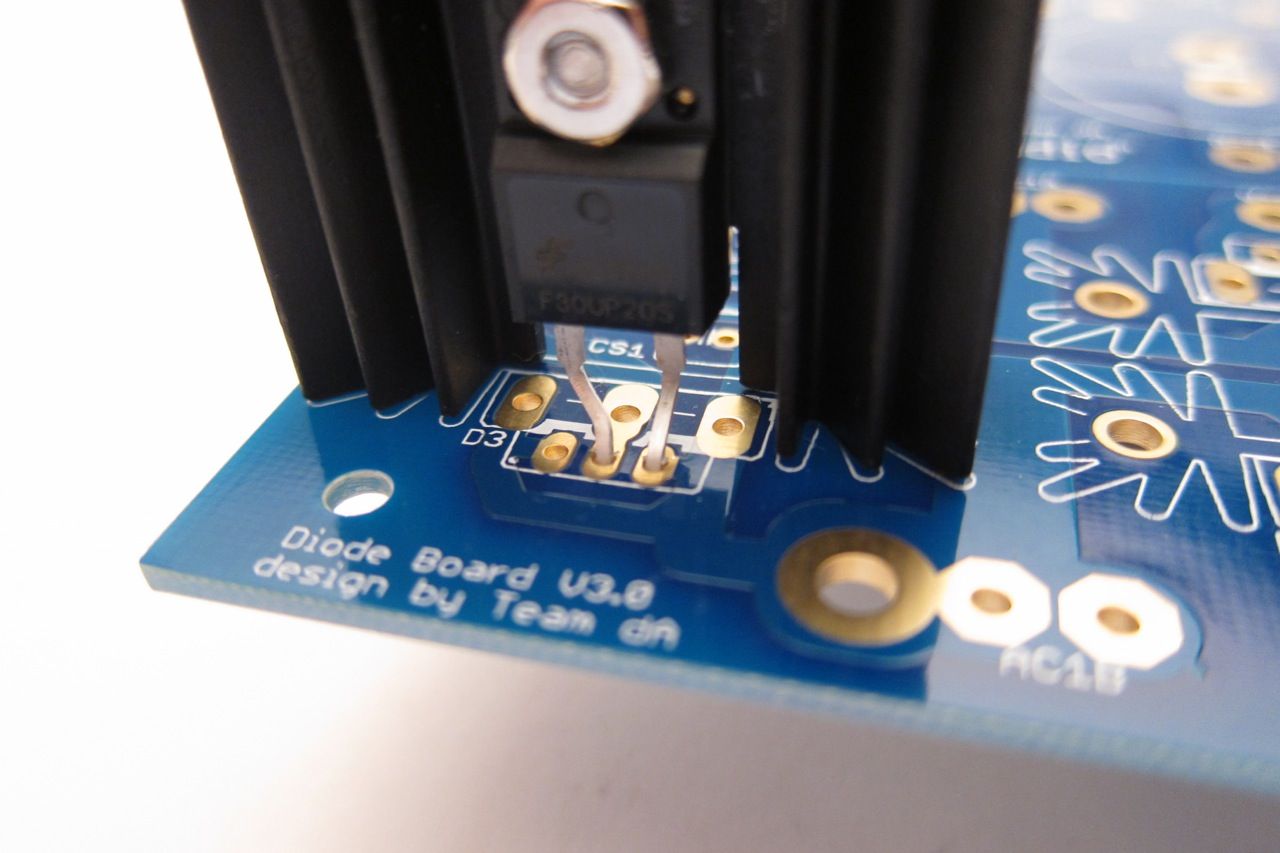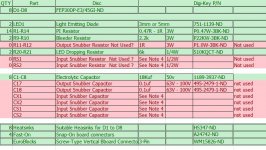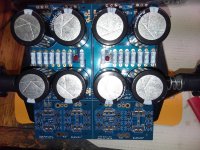Well, I have learn another thing while soldering these condensers.
I had no more solder, I went to buy and started but it didn't work out very well at all.
Guess what ! The UE which deep its nose in every napkin, decided to forbid lead.
So I got solder made of Tin only and it need 50 to 70° Celcius more!
What a pain ! I hope I didn't heated too much these Nichicon !
I am going to throw that crap away and get a good old lead+tin solder.
I had no more solder, I went to buy and started but it didn't work out very well at all.
Guess what ! The UE which deep its nose in every napkin, decided to forbid lead.
So I got solder made of Tin only and it need 50 to 70° Celcius more!
What a pain ! I hope I didn't heated too much these Nichicon !
I am going to throw that crap away and get a good old lead+tin solder.
F5T PSU for V2
Okay people, it's been a very long time, sine I got my EE and I think I forgot most of it.
How's about a sanity check from you lovely people.
I'm using the Universal PSU board from DIY (Thank you very much)
Pass v3 board building Turbo v2
AN-6224 - 600VA 24V Transformer
I read where the snubbers are not needed for Class A, so they have been omitted. Please take a look and correct me if I have anything wrong, missing, or suggestions for changes.
Special thanks to 6l6 for his work here and to the late AndrewT for his no ******** to the point info. Also, all the others, I have read hundreds of pages getting ready for this build and am still rather clueless.
Okay people, it's been a very long time, sine I got my EE and I think I forgot most of it.
How's about a sanity check from you lovely people.
I'm using the Universal PSU board from DIY (Thank you very much)
Pass v3 board building Turbo v2
AN-6224 - 600VA 24V Transformer
I read where the snubbers are not needed for Class A, so they have been omitted. Please take a look and correct me if I have anything wrong, missing, or suggestions for changes.
Special thanks to 6l6 for his work here and to the late AndrewT for his no ******** to the point info. Also, all the others, I have read hundreds of pages getting ready for this build and am still rather clueless.
Attachments
I myself prefer to include Rs1, Cx1, Cs1 and Rs2, Cx2, Cs2 after doing a quick Quasimodo test.
In your final amplifier, either the transformer rings, or it doesn't. The cost of installing those components (2 resistors, 4 capacitors) to absolutely guarantee that it doesn't ring, is so cheap that I just always include them. If they weren't strictly necessary in this particular amplifier, so what? They saved me the hassle (and possible mains hazards) of performing lab measurements on a fully assembled F5T which is driving multi hundred watt dummy load resistors. Just to find out whether it does or doesn't ring without those R's and C's. My personal reaction is: no thanks. Of course different folks think about it a different way, and come to different conclusions.
I looked up your AN-6224 transformer in the Quasimodo results thread but, unfortunately, nobody has reported any measurement results on that particular unit.
_
In your final amplifier, either the transformer rings, or it doesn't. The cost of installing those components (2 resistors, 4 capacitors) to absolutely guarantee that it doesn't ring, is so cheap that I just always include them. If they weren't strictly necessary in this particular amplifier, so what? They saved me the hassle (and possible mains hazards) of performing lab measurements on a fully assembled F5T which is driving multi hundred watt dummy load resistors. Just to find out whether it does or doesn't ring without those R's and C's. My personal reaction is: no thanks. Of course different folks think about it a different way, and come to different conclusions.
I looked up your AN-6224 transformer in the Quasimodo results thread but, unfortunately, nobody has reported any measurement results on that particular unit.
_
Thanks Mark, I'm certainly would use them if I had a clue what values to use. In hindsight, I maybe I should have went to the Q-Test thread and looked trans that would fit my build with data.... If you were not so damn far I'd bring the beer and we could test it. 
Aside from that, I think that thread had build plans... Hmmm
JT
Aside from that, I think that thread had build plans... Hmmm
JT
I myself prefer to include Rs1, Cx1, Cs1 and Rs2, Cx2, Cs2 after doing a quick Quasimodo test.
In your final amplifier, either the transformer rings, or it doesn't. The cost of installing those components (2 resistors, 4 capacitors) to absolutely guarantee that it doesn't ring, is so cheap that I just always include them. If they weren't strictly necessary in this particular amplifier, so what? They saved me the hassle (and possible mains hazards) of performing lab measurements on a fully assembled F5T which is driving multi hundred watt dummy load resistors. Just to find out whether it does or doesn't ring without those R's and C's. My personal reaction is: no thanks. Of course different folks think about it a different way, and come to different conclusions.
I looked up your AN-6224 transformer in the Quasimodo results thread but, unfortunately, nobody has reported any measurement results on that particular unit.
_
I assume “ringing” is detectable on a scope or simulation, but what are the audible effects of a ringing transformer in the listening experience? Blurred transient response? Just trying to get my head around this.
I myself prefer to include Rs1, Cx1, Cs1 and Rs2, Cx2, Cs2 after doing a quick Quasimodo test.
I agree. I just built a PSUv3 based on the AnTek AS-4224 - 400VA 24V transformer and included the Quasimodo recommended snubber because it is so cheap and easy to do so... and so what if it didn't make much difference? It was cheap and easy!
I built the Quasimodo test jig prior to this PSU build because - let's be honest - this is not the last PSU I'll be building. I did already have an o-scope... That could be an issue for some, but they've come down in price so much, maybe it's worth it? You'll use it for lots of stuff...
I assume “ringing” is detectable on a scope or simulation, but what are the audible effects of a ringing transformer in the listening experience? Blurred transient response? Just trying to get my head around this.
Yes, you can see it on a scope. I haven't tried SPICE.
The ringing is fairly high frequency, so if it gets through the PSU filtering it's probably going to over-sharpen the transients rather than blur them. My guess is that produces sibilance?
I doubt you can hear it. But I got to build a cool test rig, and I got to re-learn how to use the 1980s oscilloscope I've had for ages, and the snubbers look decorative on the ends of my double-bridge boards. What's not to like?
Cheers,
Jeff.
I no longer have a scope, so there's that too. All my profs have since retired, or I could just slide into a lab... might be able to do that anyway. I will have to build the cheapmodo and see what I can see. Unless someone has one out there that they no longer need let me know if someone is willing to part with, or loan one. I will, build one for future builds over the winter when there is more time.
I will keep an eye out for a good used scope, as money allows.
I will keep an eye out for a good used scope, as money allows.
I assume “ringing” is detectable on a scope or simulation, but what are the audible effects of a ringing transformer in the listening experience? Blurred transient response? Just trying to get my head around this.
Yes it's detectable both in simulation and in the real world using an oscilloscope.
BUT, the magnitude and frequency of the ringing are dependent upon the choice of transformer, the choice of rectifier, the load current drawn by the downstream electronics, and other variables.
Some (happy!) combinations of these result in a resonant RLC circuit that is well damped even with no secondary snubber circuit attached. And they don't ring at all. Connecting a snubber to make double, triple, quintuple sure they don't ring, doesn't hurt but it also doesn't help either.
Other combinations of these result in Mucho Ugly Ringing, and a well chosen secondary snubber damps this out to nothing. Zero. Nada.
Which is a longwinded way of saying: it all depends. In some cases, adding a snubber has no effect. In other cases, it completely eliminates unwanted HF noise inside the chassis.
There are a few posts here on diyAudio in the Quasimodo thread, where people did before-and-after listening tests. My foggy memory of them is that about 3/4 of listeners found positive improvement, 1/4 of listeners found no improvement, and just about nobody found negative improvement (sound got worse after snubbers were installed).
Remember that many MANY well-loved pieces of classic audio gear, sound wonderful and have no transformer secondary snubbers whatsoever. Would they sound even better if retrofitted with snubbers today? Insert your opinion here. Better yet, go hack apart your collector's edition $75K Mark Levinson ML-2, install optimum snubbers, and give it a listen. Report data here please!
Getting Started on F5T V2
Bit of an update, not that anyone asked for it. I got the parts and proto to do the Quasimodo mytrans. Also, didn't have a scope, so i picked up a Rigol DS1054Z, I know analog would be better for this particular project... I read you can turn on most of the advanced features with a little effort.
I got the parts and proto to do the Quasimodo mytrans. Also, didn't have a scope, so i picked up a Rigol DS1054Z, I know analog would be better for this particular project... I read you can turn on most of the advanced features with a little effort.
I figured if I was going to do this thing I might as well do it right, and if not that, at least to the best of my ability not cutting corners hoping it will work and work well
A quick shot to let ya'll know I'm actually building one.
Bit of an update, not that anyone asked for it.
I figured if I was going to do this thing I might as well do it right, and if not that, at least to the best of my ability not cutting corners hoping it will work and work well
A quick shot to let ya'll know I'm actually building one.
Attachments
If you decide to use the diode portion of the PCB (bottom of photo in #956) with two-legged diodes, I encourage you to go slowly. Look at the photos attached to post #1 in this thread, for example this one:

When bending the legs, I encourage you to go slowly. If you overbend and break one of the legs, you just lost a couple dollars. Worse still, you may not have ordered extra diodes, so now you need to reorder and (ugh!) wait for the second shipment.

When bending the legs, I encourage you to go slowly. If you overbend and break one of the legs, you just lost a couple dollars. Worse still, you may not have ordered extra diodes, so now you need to reorder and (ugh!) wait for the second shipment.
@Mr. Johnson
You know I noticed that photo when reading and I wondered about the 2 leg package there?
I'm using FEP30DP-E3/45GI-ND anything I need to know there? I was holding off installing until I looked at the snubber in the middle of the diodes. I have read so many pages, that I'm a little confused on where and what with the snubbers.
You know I noticed that photo when reading and I wondered about the 2 leg package there?
I'm using FEP30DP-E3/45GI-ND anything I need to know there? I was holding off installing until I looked at the snubber in the middle of the diodes. I have read so many pages, that I'm a little confused on where and what with the snubbers.
The diyAudio PSU board makes an effort to appeal to everybody, hence the word "Universal" in its name
Universal Power Supply – diyAudio Store
Some people want to use diodes with 2 legs. The Universal PCB allows that.
Some people want to use diodes with 3 legs. The Universal PCB allows that too.
Some people want "transformer secondary snubbers" so the Universal PCB includes them: CX1,CS1,RS1,CX2,CS2,RS1. If you want them, put them in.
Some people want "DC rail snubbers" so the Universal PCB includes them: C17,R12,C18,R11. If you want them, put them in.
Some people don't want either of those. It's easy: just don't stuff and solder them in the Universal PCB.
And some people don't really know what they want. About the only thing they can do is ask somebody they trust, "tell me what YOU wanted when you built your PCB, so that I may copy you."
Universal Power Supply – diyAudio Store
Some people want to use diodes with 2 legs. The Universal PCB allows that.
Some people want to use diodes with 3 legs. The Universal PCB allows that too.
Some people want "transformer secondary snubbers" so the Universal PCB includes them: CX1,CS1,RS1,CX2,CS2,RS1. If you want them, put them in.
Some people want "DC rail snubbers" so the Universal PCB includes them: C17,R12,C18,R11. If you want them, put them in.
Some people don't want either of those. It's easy: just don't stuff and solder them in the Universal PCB.
And some people don't really know what they want. About the only thing they can do is ask somebody they trust, "tell me what YOU wanted when you built your PCB, so that I may copy you."
I do get the universal aspect, and understand it was the best, most cost effective, way to get a workable solution for many builds. I'm also sure it was a headache to think about all the possible permutation and put a board out that was truly diverse and functional.
The problem comes in when you got guys like me trying to build on them. There are so many threads and posts, it's hard to follow and also find the build that YOU want to do.
There are so many threads and posts, it's hard to follow and also find the build that YOU want to do.
I guess I need the PASS amp for dummies book.
Okay, "Tell me what you wanted when you built yours, so I may copy you!"
The problem comes in when you got guys like me trying to build on them.
I guess I need the PASS amp for dummies book.
Okay, "Tell me what you wanted when you built yours, so I may copy you!"
... I got the parts and proto to do the Quasimodo mytrans. Also, didn't have a scope, so i picked up a Rigol DS1054Z, I know analog would be better for this particular project... I read you can turn on most of the advanced features with a little effort.
I figured if I was going to do this thing I might as well do it right, and if not that, at least to the best of my ability not cutting corners hoping it will work and work well.
Excellent! You're on your way now.
- Home
- Amplifiers
- Power Supplies
- diyAudio Power Supply Circuit Board v3 illustrated build guide

